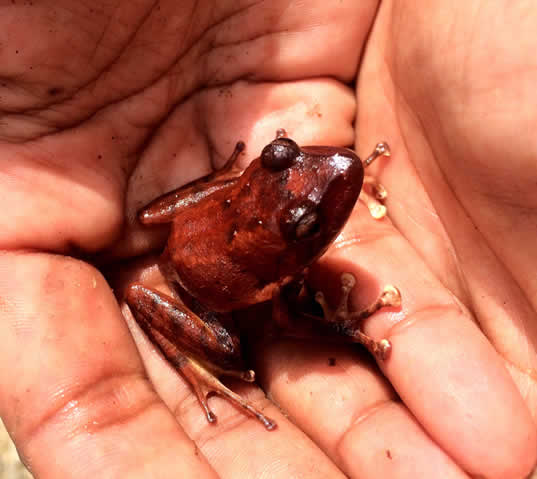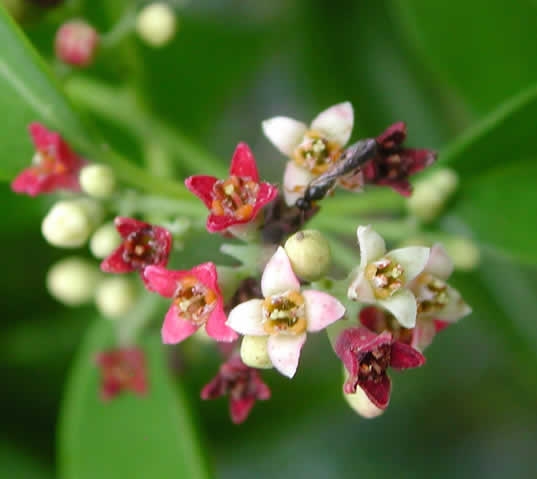
Forest ecosystems present in Fiji include lowland rainforest, upland rainforest, cloud forest, tropical dry forest, talasiga (shrub grassland), mangroves, coastal strand forest and man-made agroforests. Fiji is included in the Micronesia-Polynesia biodiversity hotspot – considered to be one of the most threatened of earth’s 34 biodiversity hotspots – and many Fijian plant species are unique.
Fiji also has its own endemic family of flowering trees, the Degeneraceae, distantly related to magnolias. This ancient plant family evolved about 100 million years ago and is now only represented by two Degeneria species in Fiji: unusual characteristics include the spiral arrangement of its flower parts and its seed leaves which are typically borne in threes (rather than the usual one for monocotyledons and two for dicotyledons). Degeneria is the Fiji Botanic Gardens’ emblem.
Fiji has six other unique/endemic plant genera: four of these, Gillespiea, Hedstromia, Readea and Squamellaria, are in the rose family Rubiaceae, while Amaroria is in the quassia family Simaroubaceae and Neoveitchia is in the palm family Arecaceae.
Most of Fiji’s rich flora and its 476 plant genera have been derived from and are shared with the island of New Guinea and south-east Asia to the west. However, Fiji also has distinctive Gondwanan or Antarctic floral links which include both conifers Agathis (kauri pine), Dacrydium, Dacrycarpus and Podocarpus (plum pines) and flowering plants Meterosideros (in the myrtle family Myrtaceae) and Turrillia (in the protea family Proteaceae). It has been speculated that a small piece of Gondwana drifted near to Fiji for millions of years, allowing plants to hop across to Fiji and evolve into new entities, before this island collided into ‘Eua in southern Tonga.
There is also a high level of endemism among the 1,800 native Fijian plant species. Fiji is a biodiversity hotspot for palms with 24 of our 30 native species being only found in Fiji, while In the genus Psychotria 72 of the 76 nati ve Fijian species are endemic.
Savurua aims to include specimens of Fiji’s endemic genera and species which can be successfully cultivated under the local climatic and soil conditions in each garden.
Whilst there is an urgent need to assess the conservation status of Fiji’s hundreds of rare and endemic plant species, it is vital to implement conservation measures now. These will include in situ conservation in protected areas, circa situ in the landscape and agroforestry systems, and ex situ in seed banks such as those maintained by SPC and in purposeful genetically diverse plantings such as those being undertaken by Botanical Gardens Fiji.
Botanical Gardens Fiji first site near Pacific Harbour is dedicated to conserving endangered lowland tropical rainforest plants especially endangered palms such as the local soga (Metroxylon vitiensis) and vilaito (Neoveitchia storckii) – an endemic palm with a tiny natural range in the nearby Waidina catchment. There at least seven other Fijian endemic palms that are endangered if not critically endangered that will also be conserved ex situ at in the Botanical Gardens.
Several of Fiji’s ten gymnosperm tree species are considered endangered including the endemic kuasi (Podocarpus affinis) and drautabua (Acmophyle sahniana) and these will be conserved at Pacific Harbour. For more, check out our Conservation Page.
In addition to conserving rare species, the gardens will establish genetically diverse stands of Fiji’s most important native forestry trees, such as yasi sandalwood (Santalum yasi), kauvula (Endospermum macrophyllum), dakua makadre (Agathis macrophylla) and yaka (Dacrydium nidulum) to act as a seed source for future reforestation activities.
Other botanical gardens planned for Nausori Highlands near Nadi will conserve Fiji’s highly threatened tropical dry forest trees such as cibicibi (Cynometra falcata) and highlands yaka (Dacrydium nausoriense), while a Botanical Gardens near Laulau in Naitasiri Province will conserve endangered agrobiodiversity such as rare and threatened varieties of indigenous fruit and nut trees, including breadfruit, and bananas.
Fiji’s diverse ecosystems are a haven to great biological diversity to which is both economically and culturally vital for Fijians.
Fijians have an extensive in-depth traditional local knowledge of trees, forests and other ecosystems in which trees are found. There is also great knowledge of the plants, animals and other organisms that depend on trees and forests for their survival, and of the uses and cultural importance of trees and the other plants and animals and other materials that are found in Fiji’s forest ecosystems.
However, most traditional knowledge about trees and Fiji’s ecosystems in which trees are found has not been systematically recorded, and is in danger of being lost if it isn’t recorded and, where appropriate, taught to the younger generation and used as a basis for the conservation and sustainable use of forests, trees and plants.
At least 450 native and introduced species are used for medicines, with several dozen being used frequently, e.g. Calophyllum inophyllum (tamanu or dilo), Centella asiatica (totodro), Epipremnum pinnatum (yalu), Morinda citrifolia (noni or kura, Mussaenda raiatenis (bobo), Pometia pinnata (oceanic lychee or dawa), Premna serratifolia (yaro), Vitex trifolia (vulukaka), Syzygium malaccense (malay apple) and Terminalia catappa (tavola).
Through its planned work with schools, educational institutes and women’s groups, Botanical Gardens Fiji will help foster traditional knowledge, conserve and make available planting materials of Fiji’s important cultural and medicinal plants.
A one kilometre cultural and medicinal plants path is being developed at the Pacific Harbour site which will include more than one hundred of the most important cultural and medicinal trees and plants. Guided walks led by local experts will enhance visitors’ appreciation of Fijian culture and knowledge.

Savurua Botanical Gardens is a mecca for endemic Fijian forest birds: intact and diverse lowland tropical forest

The majestic Fijian sago palm (Metroxylon vitiense) or soga, pronounced songa in Fijian, is an endangered palm unique to Fiji.

Savurua Botanical Gardens is 100% committed to conserving Fijian plant species especially endangered endemic trees.
Are you passionate about creating a greener, lusher Fiji? Donate to our conservation initiatives & help protect Fiji’s indigenous flora, fauna & rainforests. It’s a green ‘thumbs up’ for Fiji!